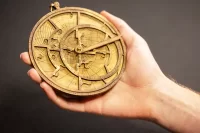Chimpanzee 'doll' play suggests some biological basis for gender-specific play by humans
An article published by two researchers from Bates and Harvard in the Dec. 21 issue of Current Biology is capturing the attention of media around the world this week.
In their study, Bates biologist Sonya M. Kahlenberg and biological anthropologist Richard W. Wrangham of Harvard described the first suggestive evidence of a wild non-human species playing with rudimentary dolls, as well as the first known sex difference in a wild animal’s choice of playthings.
As a report in Science News states, the research “supports a controversial view that biology as well as society underlies boys’ and girls’ contrasting toy preferences.”
Their study of Ugandan chimpanzees spanned 14 years and showed that juveniles carried sticks as they went about their daily activities without using them for any particular purpose, such as foraging. They even sometimes slept in nests with their sticks. The researchers suggest that these may in fact be ‘dolls’ and, as in human children, found the behavior is more common in females than males. Adult females do not carry sticks once they have infants of their own, also suggesting a link with play mothering.
Given that chimpanzees and humans are closely related, the researchers say their work adds to a growing body of evidence that human children too are probably born with their own ideas of how they want to behave, rather than simply mirroring other girls who play with dolls and boys who play with trucks.
“In humans, there are robust sex differences in children’s toy play, and these are remarkably similar across cultures,” says Kahlenberg. “While socialization by elders and peers has been the primary explanation, our work suggests that biology may also have an important role.”
Regular doll-like stick play has not yet been reported from any other chimpanzee group, so it’s possibly unique to the Ugandan population studied. If so, the practice may have a cultural as well as biological component.
“It’s likely that how all chimpanzees play is influenced by their sex,” Kahlenberg says, “But only at our study site did the juvenile females get the clever idea to use sticks as ‘dolls.’ So this is a neat case that demonstrates how intertwined nature and nurture are when it comes to influencing behavior.”
Some of first stories:
Current Biology
http://www.cell.com/current-biology/abstract/S0960-9822%2810%2901449-1
USA Today
The New York Times
http://www.nytimes.com/2010/12/21/science/21obchimpanzee.html?_r=1
National Geographic
Science News (carried in U.S. News & World Report)
http://www.usnews.com/science/articles/2010/12/20/female-chimps-play-with-dolls.html
LA Times
http://www.azcentral.com/news/articles/2010/12/20/20101220female-chimps-play-with-dolls.html
The Guardian
http://www.guardian.co.uk/science/2010/dec/20/chimps-play-male-female-genetic
Discovery News
http://news.discovery.com/animals/female-chimps-dolls-sticks-101220.html
Wired.com
http://www.wired.com/wiredscience/2010/12/chimp-dolls/
New Scientist (UK)
http://www.newscientist.com/article/dn19890-wild-chimps-make-their-own-dolls.html
Harvard Gazette
http://news.harvard.edu/gazette/story/2010/12/female-chimps-treat-sticks-as-dolls/
Science Magazine
http://news.sciencemag.org/sciencenow/2010/12/do-chimps-play-with-dolls.html?ref=hp
In coming weeks, look for news accounts on the research findings in other science-oriented publications as well as media serving the general public. In addition to links above, Kahlenberg and co-author Wrangham have been interviewed or had their publication requested by the Times (London), CNN International, National Geographic Magazine, Discovery Channel, BBC Wildlife Magazine, BBC Radio, CBS Radio, NPR Radio and other news media from Brazil to India.




